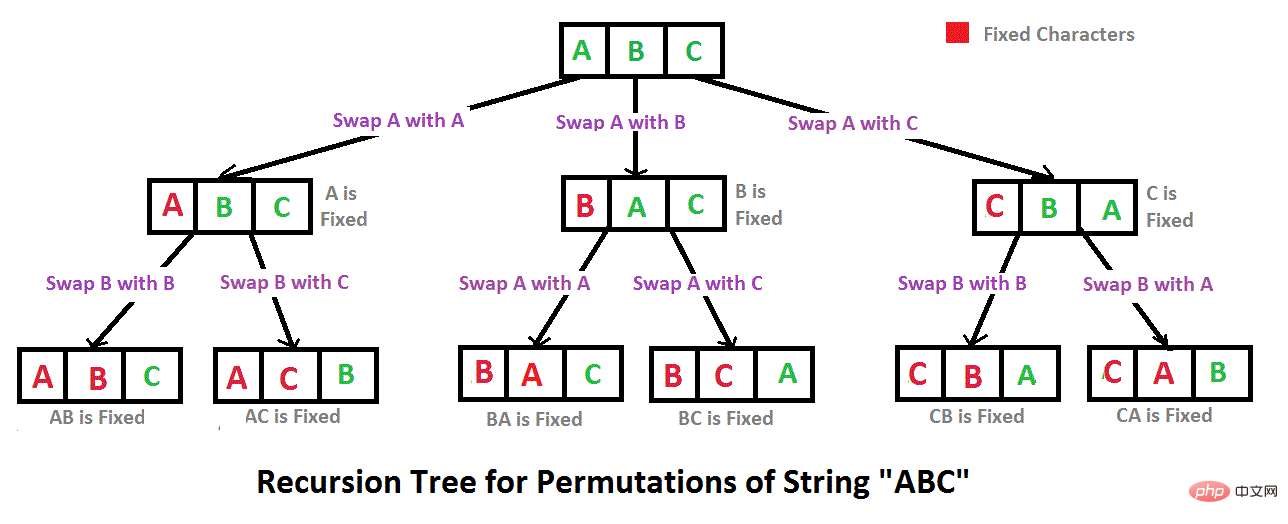Maison >développement back-end >tutoriel php >[PHP Learning] Comment obtenir un arrangement complet de chaînes
[PHP Learning] Comment obtenir un arrangement complet de chaînes
- little bottleavant
- 2019-04-23 17:23:282891parcourir
Le contenu principal de cet article concerne l'utilisation de PHP pour réaliser l'arrangement complet des chaînes. Il a une certaine valeur de référence. Les amis intéressés peuvent en apprendre davantage.
Saisissez une chaîne et imprimez toutes les permutations de caractères dans la chaîne dans l'ordre du dictionnaire.
Par exemple, si vous saisissez la chaîne abc, toutes les chaînes abc, acb, bac, bca, cab et cba qui peuvent être organisées par les caractères a, b, c seront imprimées.
Idées :
1. Utilisez la récursivité pour former un arbre récursif, obtenez l'effet de priorité en profondeur et corrigez la première lettre
2. La priorité en profondeur ne peut être refaite qu'après la réinitialisation
<.>3. Méthode de retour en arrière Réflexions4. Une image et un processus opérationnel ne peuvent être compris que lentement<?phpfunction test($str,$start,&$res){ //递归终止条件
if($start==strlen($str)){ $res[]=$str; return;
}
//
for($i=$start;$i<strlen($str);++$i){ if($i==$start || $str{$i}!=$str{$start}){
swap($str,$i,$start);var_dump($str.'==='.$start);var_dump($res);sleep(1);
test($str,$start+1,$res);
swap($str,$i,$start);
}
}
return $res;
}function swap(&$str,$a,$b){
if(!is_string($str)) return;
$t=$str{$a};
$str{$a}=$str{$b};
$str{$b}=$t;
}$str="abc";$res=array();//调用入口,从索引0开始
$res=test($str,0,$res);
var_dump($res);string(7) "abc===0"array(0) {
}string(7) "abc===1"array(0) {
}string(7) "abc===2"array(0) {
}string(7) "acb===1"array(1) {
[0]=> string(3) "abc"}string(7) "acb===2"array(1) {
[0]=> string(3) "abc"}string(7) "bac===0"array(2) {
[0]=> string(3) "abc"
[1]=> string(3) "acb"}string(7) "bac===1"array(2) {
[0]=> string(3) "abc"
[1]=> string(3) "acb"}string(7) "bac===2"array(2) {
[0]=> string(3) "abc"
[1]=> string(3) "acb"}string(7) "bca===1"array(3) {
[0]=> string(3) "abc"
[1]=> string(3) "acb"
[2]=> string(3) "bac"}string(7) "bca===2"array(3) {
[0]=> string(3) "abc"
[1]=> string(3) "acb"
[2]=> string(3) "bac"}string(7) "cba===0"array(4) {
[0]=> string(3) "abc"
[1]=> string(3) "acb"
[2]=> string(3) "bac"
[3]=> string(3) "bca"}string(7) "cba===1"array(4) {
[0]=> string(3) "abc"
[1]=> string(3) "acb"
[2]=> string(3) "bac"
[3]=> string(3) "bca"}string(7) "cba===2"array(4) {
[0]=> string(3) "abc"
[1]=> string(3) "acb"
[2]=> string(3) "bac"
[3]=> string(3) "bca"}string(7) "cab===1"array(5) {
[0]=> string(3) "abc"
[1]=> string(3) "acb"
[2]=> string(3) "bac"
[3]=> string(3) "bca"
[4]=> string(3) "cba"}string(7) "cab===2"array(5) {
[0]=> string(3) "abc"
[1]=> string(3) "acb"
[2]=> string(3) "bac"
[3]=> string(3) "bca"
[4]=> string(3) "cba"}array(6) {
[0]=> string(3) "abc"
[1]=> string(3) "acb"
[2]=> string(3) "bac"
[3]=> string(3) "bca"
[4]=> string(3) "cba"
[5]=> string(3) "cab"} 
Ce qui précède est le contenu détaillé de. pour plus d'informations, suivez d'autres articles connexes sur le site Web de PHP en chinois!

